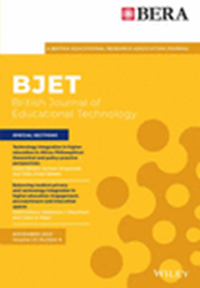Seeking to support preservice teachers' responsive teaching: Leveraging artificial intelligence-supported virtual simulation
Abstract
Preparing preservice teachers (PSTs) to be able to notice, interpret, respond to and orchestrate student ideas—the core practices of responsive teaching—is a key goal for contemporary science and mathematics teacher education. This mixed-methods study, employing a virtual reality (VR)-supported simulation integrated with artificial intelligence (AI)-powered virtual students, explored the frequent patterns of PSTs' talk moves as they attempted to orchestrate a responsive discussion, as well as the affordances and challenges of leveraging AI-supported virtual simulation to enhance PSTs' responsive teaching skills. Sequential analysis of the talk moves of both PSTs (n = 24) and virtual students indicated that although PSTs did employ responsive talk moves, they encountered difficulties in transitioning from the authoritative, teacher-centred teaching approach to a responsive way of teaching. The qualitative analysis with triangulated dialogue transcripts, observational field notes and semi-structured interviews revealed participants' engagement in (1) orchestrating discussion by leveraging the design features of AI-supported simulation, (2) iterative rehearsals through naturalistic and contextualized interactions and (3) exploring realism and boundaries in AI-powered virtual students. The study findings provide insights into the potential of leveraging AI-supported virtual simulation to improve PSTs' responsive teaching skills. The study also underscores the need for PSTs to engage in well-designed pedagogical practices with adaptive and in situ support.
Practitioner notes
What is already known about this topic
- Developing the teaching capacity of responsive teaching is an important goal for preservice teacher (PST) education. PSTs need systematic opportunities to build fluency in this approach.
- Virtual simulations can provide PSTs with the opportunities to practice interactive teaching and have been shown to improve their teaching skills.
- Artificial intelligence (AI)-powered virtual students can be integrated into virtual simulations to enable interactive and authentic practice of teaching.
What this paper adds
- AI-supported simulation has the potential to support PSTs' responsive teaching skills.
- While PSTs enact responsive teaching talk moves, they struggle to enact those talk moves in challenging teaching scenarios due to limited epistemic and pedagogical resources.
- AI-supported simulation affords iterative and contextualized opportunities for PSTs to practice responsive teaching talk moves; it challenges teachers to analyse student discourse and respond in real time.
Implications for practice and/or policy
- PSTs should build a teaching repertoire with both basic and advanced responsive talk moves.
- The learning module should adapt to PSTs' prior experience and provide PSTs with in situ learning support to navigate challenging teaching scenarios.
- Integrating interaction features and AI-based virtual students into the simulation can facilitate PSTs' active participation.



 求助内容:
求助内容: 应助结果提醒方式:
应助结果提醒方式:


